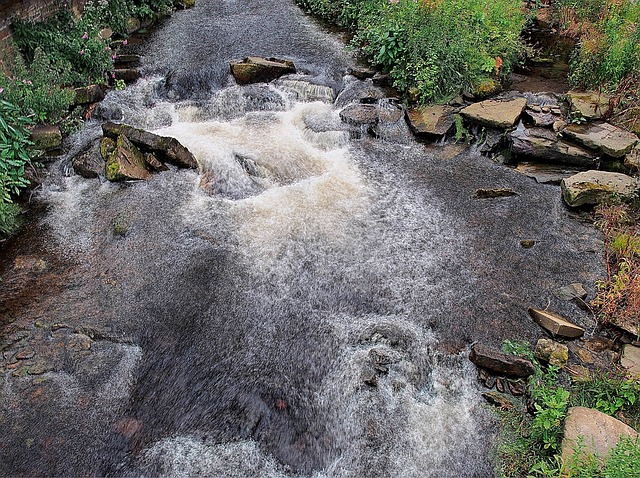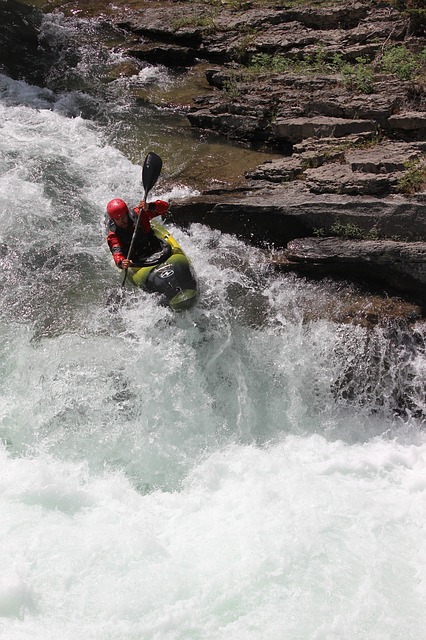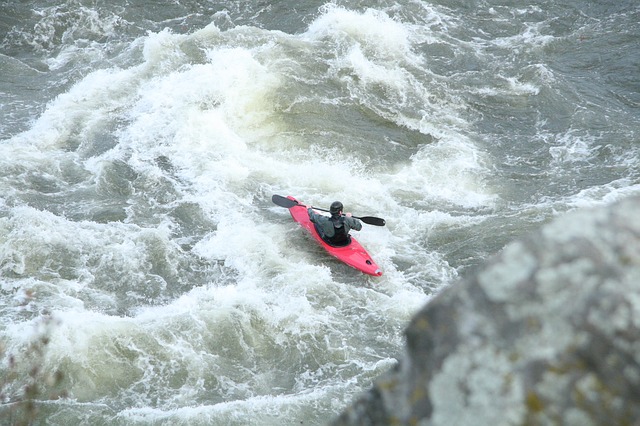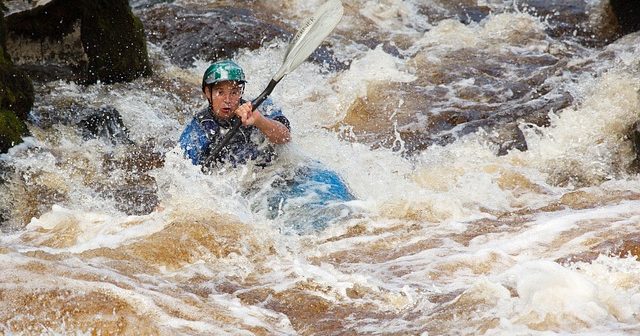Are you intimidated by the power of whitewater? If you are, you’re not alone. Lots of people are afraid of surging whitewater. Rivers with whitewater often seem frightening and chaotic, because we aren’t familiar with the way that currents within these waterways flow. After we become more familiar, by learning about the features which contribute to currents, including downstream Vs, waves, rocks, eddies, eddy lines and hydraulics, we begin to make sense of rivers. The process of analyzing a river is known as “reading a river”. Today, we want to share basic information about how to read a river.
Once you learn how to read a river, you’ll be primed to find the best pathway through the water. Mapping out this type of pathway will build your confidence. You’ll be able to decide if your kayaking skills are good enough to “run the line” safely.
Developing the capacity to read whitewater accurately will require a bit of time. It may also require some trial and error. When you pick a line (a route) for a river and then run it in your kayak, you’ll be testing your river reading skills. If you misread the water, you may end up capsizing.
We recommend analyzing gentler rivers first. We also think that newbies should take kayaking lessons from skilled instructors with good credentials. Our tips are meant to augment training that is accessed via kayaking lessons. Our tips are also appropriate for recreational kayaking enthusiasts who generally stick to rivers with slow-moving, easy currents.
Discover the Downstream V
This feature is something that you need to recognize. With the “downstream V”, green or dark water makes up the center part of the “V” and whitewater makes up the edges of the V. When you start to read rivers, you’ll begin to notice these loosely-formed ‘vees”. The vees will point in downstream directions.
A downstream V will show you where the water is the deepest. The deepest water in a whitewater river is usually the best water to paddle through, particularly when rapids have Class II or Class III designations. This is why finding a downstream V is a good starting point for mapping out a route. It’s a clue which will show you which line is the safest.
The downstream V indicates a section of the river where there is flow which is unobstructed.
Whitewater develops when water flows over debris or rocks in a riverbed. Whitewater is sign of obstructions within the river. Some waterways have deep whitewater and others have shallower whitewater. When you find the downstream V, you’ll discover a deep and obstacle-free entryway to a rapid.
Downstream “vees” typically lead to waves that are friendly and fun. A “V” may also be known as a tongue.
It’s simpler to spot these V shapes from high up, so find a good spot on the shore and then keep an eye out for them. As you begin to seek out downstream Vs, it’ll become much easier to identify them. In some cases, you may need to be pretty close to a rapid’s tip before the downstream V is visible.
If you’re in your kayak and moving towards a rapid, and you’re not really positive that you can see a “vee”, you may want to go ashore, rather than running the whitewater rapid “blind”.
Learn to Recognize Eddies

Eddies are places in rivers where currents flow upstream. Eddies are caused by downstream currents flowing around obstacles, such as rocks. The obstacles push the water upstream. The same thing may occur when there is a piece of land which juts out from the water. Currents are deflected by points of land and a space is created that a current flows into. The current will then flow upstream.
An eddy is a place where it’s possible to rest for a bit, or exit the river if you want to. In rivers with slower-moving currents, eddies are practically stagnant. If they aren’t stagnant, they may have very slow flow. This means that they are ideal places to take a break.
In rivers that flow at faster speeds, eddies usually have currents which flow quickly. These eddies may seem chaotic.
It’s vital to recognize eddies. They are areas of respite which offer kayaking enthusiasts a break from the intensity of whitewater. A good kayaking instructor will be able to show you how to recognize eddies. He or she will also be able to show you how to get into eddies and get out of eddies.
Eddy Lines May Be Dangerous
Eddy lines are swirling lines which are found at the edges of eddies, where downstream-flowing current meets upstream-flowing current. Eddy lines are currents which are unstable. It’s pretty simple to recognize the most defined eddy lines. However, eddy lines which are not as well-defined may be a lot tougher to spot.
In a slow-moving river, eddy lines shouldn’t be a big problem. In a fast-moving river, eddy lines should be avoided, because paddling into them may cause your kayak to flip over.
Rocks are Hazards in Currents

Rocks are typical parts of every river. They’re all around in the current and on the shore. To avoid rocks, you’ll need to understand that the water’s current is continually moving your kayak towards these rocks. You’re going to have to plan ahead to stay away from them.
If you spot a rock too late, it may not be possible to avoid it while you’re in your kayak. The key to staying away from rocks is looking ahead and making moves early on.
One expert tip is to look in the direction that you wish to go in, rather than looking at the rock. When you steer while you’re looking in the right direction, you’ll have a better chance of avoiding rocks. If the worst happens and you discover that you’re close to a rock, do what’s counter-intuitive. This means leaning into a rock and using it for stability.
When you do this, the current will push you around the obstacle. If you lean away from the obstacle, you’ll leave part of your kayak (the edge that’s upstream) exposed to the current and this may be enough to cause your kayak to flip over.
When rocks are right beneath the surface, the best strategy is to paddle over them. When you do this, you’ll maintain your stability and speed. When paddlers wait too long to start moving around rocks, they sometimes go over the rocks sideways…and this is not a stable way to go over rocks.
Important Information About Hydraulics
The rocks which are situated below the surface of the water make hydraulics and waves. Water flows over the stones, drops down and then surges back up. When the water comes back up, it mixes with air and this creates whitewater. Waves are made when a lot of water flows over rocks. Waves are fun to kayak in and they boost kayaking speed and make a flip-over less likely. For these reasons, waves are considered, “friendly”.
Hydraulics are a bit more unfriendly. It’s possible to surf these hydraulics and enjoy the experience. However, newbies should probably stay away from them until they develop better whitewater kayaking skills. Hydraulics happen when there are steep drop-offs in water, behind rocks, which causes a back current of significant strength to develop. These back currents flow upstream and feed current back to the “hydraulic”.
Hydraulics include big piles of foamy whitewater which flows upstream. These piles are something to look for when you’re searching for hydraulics in the river. If you hit certain hydraulics, you may get stuck there and get weary. You may need to swim out in order to get free. It’s better to stay away from them.
Try Reading a River Today

Rocks, eddy lines, eddies, hydraulics and downstream Vs are parts of all rivers. Now that you know some basic tips on how to read a river, you’ll be able to spot these elements and act accordingly.
Once you begin watching whitewater rivers closely, you’ll see that they aren’t just chaos. There are patterns and predictable elements.




